Finally.
Under the guidance of USDA-ARS and other researchers, and with the help of the California Strawberry Commission and other supporters, the UC Cooperative Extension diagnostic laboratory in Salinas finally has joined the 21st century regarding molecular diagnostic technologies. A DNA-based test is now being implemented to detect and confirm important soilborne diseases of coastal crops. This method can complete the diagnostic process in a few hours, compared to the conventional culture method, which usually takes several days.
The Need.
Rapid, accurate, and dependable diagnosis of plant diseases is an essential part of agriculture production. Without knowing the precise agent responsible for the disease, growers, pest control advisers, and other field personnel are hampered when making disease management decisions. Soilborne diseases are particularly challenging to identify. In general, the appearances of the various root rots, crown rots, plant collapses, and vascular wilts all look very similar, making it virtually impossible to diagnose these based on symptoms alone. The UC Cooperative Extension laboratory has some very accurate culture methods to grow out and detect all of these soilborne pathogens. However, such culture techniques are relatively slow and take from three to seven days to complete. For our fast growing coastal crops a more rapid means of disease diagnosis would well serve the growers.
The Method.
The new method goes by the name “RPA” which stands for recombinase polymerase amplification. The RPA method, like many other technologies such as the polymerase chain reaction (PCR), is based on DNA components (called primers and probe) that specifically recognize the corresponding DNA found in the target pathogen. However, all PCR methods depend on extracting and purifying the pathogen DNA; getting the DNA out is costly (one needs to buy expensive equipment to analyze the sample) and it requires more time to complete the elaborate procedures. RPA is perfectly suited to an extension laboratory, like the one in Salinas, because DNA purification is not needed as the test uses ground up, crude plant extracts as a source of unpurified DNA (see photos below).
Pathogens Detected.
Presently the UC Cooperative Extension laboratory offers RPA diagnostic tests for two pathogens. Phytophthora causes root and crown rots on strawberry, raspberry, and a number of vegetable crops and ornamental/forest plants. Our Phytophthora tests are either genus-specific (it will detect Phytophthora infecting many types of plants) or species-specific for the two pathogens that mostly attack strawberry (P. cactorum and P. fragariae) (Table 1). Our other RPA test detects the specific type of Macrophomina phaseolina that causes severe crown rot and collapse of strawberry. Because this Macrophomina RPA is designed for the strawberry pathogen and not for Macrophomina that infects other crops, this is called a genotype-specific test (Table 1). This summer we anticipate adding tests for the Verticillium wilt pathogen (V. dahliae that infects many crops) and the Fusarium wilt pathogen of strawberry (Fusarium oxysporum f. sp. fragariae). All tests analyze infected plant material only. However, it is hoped that our continuing research will adapt RPA or more sophisticated molecular techniques for detecting these pathogens in soil.
Table 1. RPA tests currently available at the UC Cooperative Extension laboratory.
|
Category of test |
Pathogen |
Comments |
|
Genus-specific |
Phytophthora |
Detects this pathogen in all plants, such as strawberry, raspberry, pepper, asparagus, tomato, avocado, ornamentals, forest species (sudden oak death pathogen) |
|
Species-specific |
Phytophthora cactorum |
Primarily for strawberry but this pathogen can be found on ornamentals such as coffee berry |
|
Species-specific |
Phytophthora fragariae |
For strawberry |
|
Genotype-specific |
Macrophomina phaseolina |
For Macrophomina that infects strawberry |
The Future.
Because this RPA method is similar in design to PCR, and PCR is used to develop the DNA tools (primers) to detect any sort of organism, the RPA platform is open ended. It should be possible to readily develop RPA tests for any organism that has DNA, such as other pathogenic fungi and bacteria, nematodes, and even perhaps specialized sub-groups of organisms such as insect biotypes.
Acknowledgements.
This advance in rapid, accurate disease diagnostics was developed and implemented by the following research and extension team: Mark Bolda (UC Extension, Santa Cruz Co.), Alyssa Burkhardt (USDA-ARS, Salinas), Oleg Daugovish (UC Extension, Ventura Co.), Steven Koike (UC Extension, Monterey Co.), Frank Martin (USDA-ARS, Salinas), Stacy Mauzey (UC Extension, Monterey Co.), Tim Miles (CSU Monterey Bay), and Cayla Tsuchida (UC Extension, Monterey Co.). This research was supported by the California Strawberry Commission, California Avocado Commission CSU Agricultural Research Institute (grant 5219101A), and the USDA-California Department of Food and Agriculture Specialty Crop Block Grant Program (grants SCB12051 and SCB14052 awarded to F. Martin).
Attached Images:
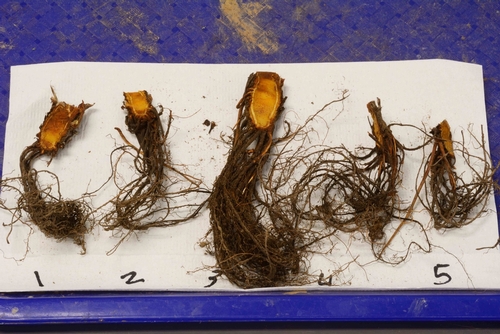
Photo 1: Strawberry samples are examined for symptomatic tissues that indicate possible disease. Photo courtesy Steven Koike, UCCE.
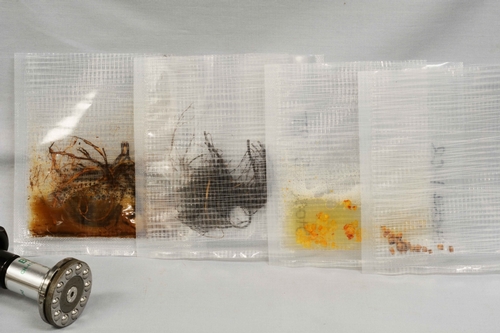
Photo 2: Pieces of root, crown, or petiole are macerated and ground up in sample bags containing buffer solutions. Photo courtesy Steven Koike, UCCE.
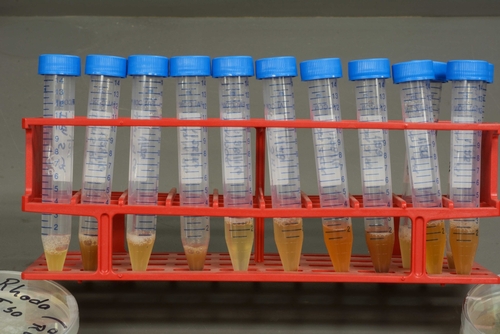
Photo 3: The resulting mixtures are strained and placed into tubes. Photo courtesy Steven Koike, UCCE.
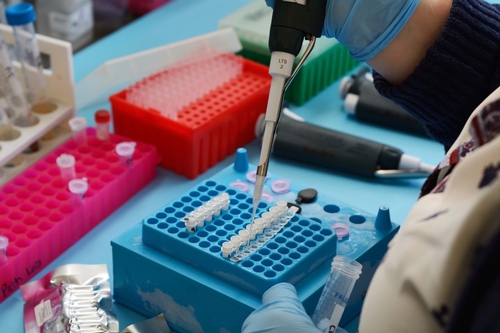
Photo 4: Small volumes of the strawberry extracts are loaded into strip tubes. Photo courtesy Steven Koike, UCCE.
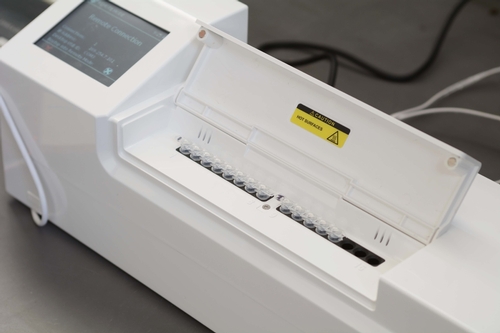
Photo 5: Loaded strip tubes are placed into the RPA isothermal detection device. Photo courtesy Steven Koike, UCCE.
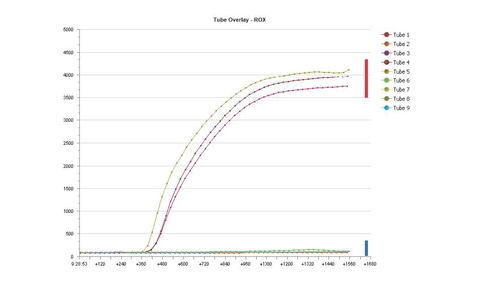
Photo 6: In the computer generated results, samples positive (red bar) for Phytophthora root and crown rot will appear as curved lines moving upwards; negative samples (blue bar) will appear as straight lines mostly remaining flat. Graphic courtesy Steven Koike, UCCE.